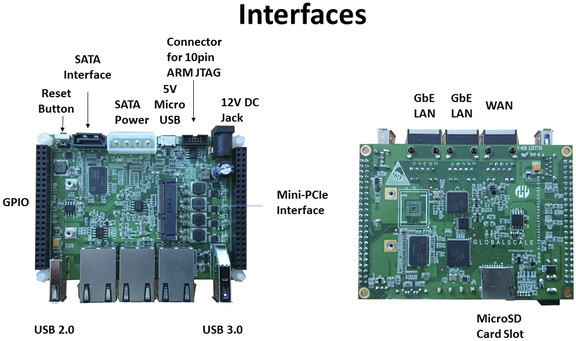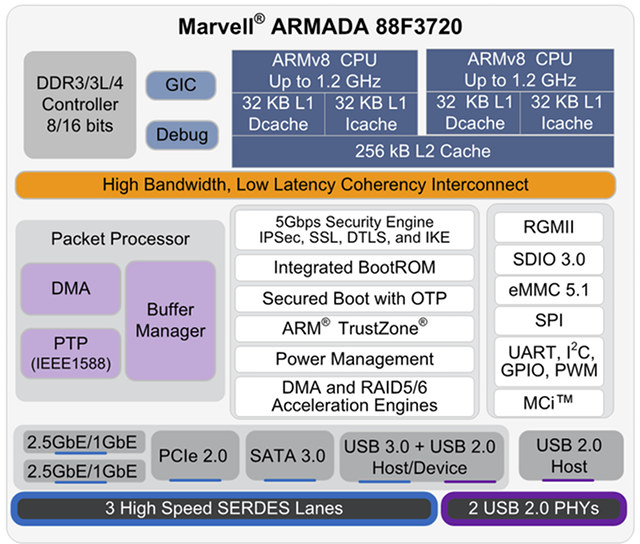I can often read people hoping for an inexpensive community board for network, storage and connectivity applications with high speed interface like SATA, multiple Gigabit Ethernet port, USB 3.0 and/or mini PCIe, and that’s exactly what Globalscale Technologies is about to offer with their Marvell ARMADA 3700 based ESPRESSOBin development board to go for $39 and up via Kickstarter.
 Marvell ESPRESSOBin board specifications:
Marvell ESPRESSOBin board specifications:
- SoC – Marvell Armada 3700LP (88F3720) dual core ARM Cortex A53 processor up to 1.2GHz
- System Memory – 512MB DDR3 or optional 1GB DDR3
- Storage – 1x SATA interface, 1x micro SD card slot with footprint for an optional 4GB EMMC
- Network Connectivity
- 1x Topaz Networking Switch
- 2x GbE Ethernet LAN
- 1x Ethernet WAN
- 1x MiniPCIe slot for Wireless/BLE periphereals
- USB – 1x USB 3.0, 1x USB 2.0, 1x micro USB port
- Expansion – 2x 46-pin GPIO headers for accessories and shields with I2C, GPIOs, PWM, UART, SPI, MMC, etc…
- Misc – Reset button, JTAG interface
- Power Supply – 12V DC jack or 5V via micro USB port
- Power Consumption – Less than 1W thermal dissipation at 1 GHz

The board will run mainline Linux & U-boot, and the company will release Ubuntu, ArchLinux ARM, Debian, and OpenWrt firmware, with support for the Yocto Project as well. Some documentation and source code can be found on the Wiki in Github.
Typical applications include NAS, video camera monitor, plex media server, IoT gateway with wireless module and/or dongle with Zigbee, Bluetooth, , Zwave…. The board was first showcased at Computex 2016.
ESPRESSOBin will be launched on Kickstarter in the next few days. Keep in mind that the page is still in draft mode, so information is subject to change, but based on the details currently available, they plan to raise at least $25,000, and a $39 early bird pledge will be asked for the first boards (with 512MB RAM), with the price going up to $49 after (with 1GB RAM). There’s also a model with a wireless module and 12V power supply for $69, and “cluster” rewards with multiple boards. Delivery is scheduled for December 2016 for early bird rewards, and February 2017 for others. If you are interested in the board, and want to make sure you don’t miss out on the early bird pledge, you can register to be notified when the project launched in the KS page.
[Update: ESPRESSOBin board can now be purchased on Amazon or Globalscale Technologies for $49 and up]
Thanks to Ray for the tip.

Jean-Luc started CNX Software in 2010 as a part-time endeavor, before quitting his job as a software engineering manager, and starting to write daily news, and reviews full time later in 2011.
Support CNX Software! Donate via cryptocurrencies, become a Patron on Patreon, or purchase goods on Amazon or Aliexpress




